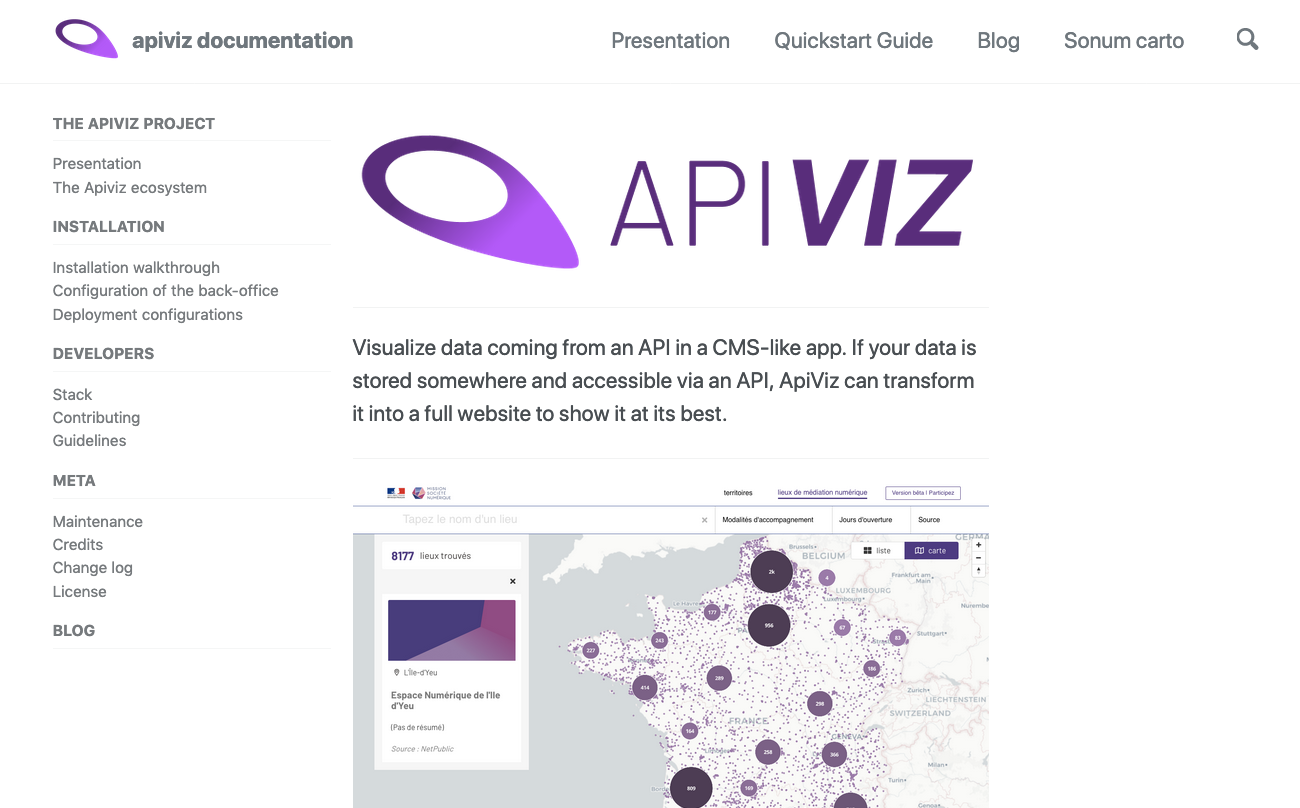Visualize data coming from an API in a CMS-like app : in short we aim to develop a Wordpress for data-visualisation.
If your data is stored somewhere and accessible via an API, ApiViz can transform it into a full website to show it at its best.
ApiViz includes "out-the-box" a back-office to fully configure/customize an original datavisualisation website
apiviz-frontend is only the frontend of the APIVIZ application, it only works if (and only) if a apiviz-backend is correctly installed first or is serving configurations to the frontend.
To fully enjoy Apiviz frontend's features if you're not using Solidata's API, your own API Rest might propose all or some of the following parameters, or equivalent when querying a dataset :
-
for the research navbar :
query: full text searrchsearch_filter: to filter out your results given a field name and a value. For instance querying all items in a 'my-data' dataset in which the field 'category' has the value 'categ01' could be similar to :https://my-api.com/my-data?search_filter=category__categ01
-
for detail view :
item_id: to search an item by its id inside a dataset
-
for table and list views :
page_number: the page numberresults_per_page: the number of items per pagesort_by: field to sort your result bysort_order: sorting ordershuffle_seed(optionnal) : if you want to shuffle the results
-
for the map view :
results_for_map: getting all the results in a condensed format, like{ id : <item_id>, lat: <latittude>, lng: <longitude>}fields_to_return: to return additional fields, for instance when usingresults_for_map=trueif you need another field(s) to link an item to a choropleth layer
Main apiviz demo website :
Official websites :
- PiNG - carto :
- CONUMM - carto :
- Décider ensemble - ressources :
- Covid-initiatives :
- TERNUM :
- RHINOCC :
Main Apiviz instances with public data :
Test websites :
Check out our brand new Apiviz presentation website : https://apiviz.io
Check out our brand new documentation website on Github pages : https://co-demos.github.io/apiviz-frontend/
ApiViz is designed to agnosticaly display data and provide an engine to deploy a datavisualisation website without (too much) pain, not regarding to the service(s) serving and storing the data.
Nevertheless to do so an instance of ApiViz must be connected to several external services : one for authentication, one for serving the data, one for storing the static contents (html pages, images...).
The goal of ApiViz is to work with any external service fulfilling those roles, but we developed an eco-system of open source applications allowing a complete and free way to deploy such a datavisualisation service.
| logo | the open source eco-system ( aka TADATA! ) |
|---|---|
| Apiviz as the high-level app for visualisation, a sort of open source CMS for data-visualisation ; | |
| Solidata to "API-fy" your data and manage open data projects ; | |
| TokTok for a dedicated authentication service to manage users, JWT, and roles. | |
| OpenScraper is a generic web scraper serving the results of the scraping via its API |
Please check out our guidelines
You can also check the development roadmap for future features
Before anything, if you want to use the whole Apiviz stack as a stand-alone app you need to install Apiviz-backend to serve your configuration to the frontend.
Otherwise, if you just want to run Apiviz frontend and plya with it, you just need to add a .env file at the root of your cloned repo. The .envfile must contain the following :
### ENV VARIABLES FOR APIVIZ FRONTEND ###
### - - - - - - - - - - - - - - - - - ###
APIVIZ_REPO=/apiviz-frontend/
DEPLOY_ENV=NETLIFY
### Apiviz backend's preprod server to serrve configs
NUXT_BACKEND_MODE=preprod
### Apiviz's distant preprod auth server to deal with login and auth
NUXT_AUTH_MODE=distant_preprod
### Apiviz's UUID to retrieve the corresponding configuration elements
### you can comment / de-comment the pair of following vars of your choice
### so you'll get the corresponding instance's specific configuration
NUXT_APP_CONFIG_NAME=DEMO_APIVIZ
NUXT_APIVIZ_UUID=89edbf7d-8b63-4088-ad14-ae6779d7698f
# NUXT_APP_CONFIG_NAME=SONUM
# NUXT_APIVIZ_UUID=c5efafab-1733-4ad1-9eb8-d529bc87c481
# NUXT_APP_CONFIG_NAME=APCIS
# NUXT_APIVIZ_UUID=f0a482da-28be-4929-a443-f22ecb03ee68
# NUXT_APP_CONFIG_NAME=TIERS_LIEUX
# NUXT_APIVIZ_UUID=fd9d4302-bddb-4fb1-8f13-d64dfdb66b91
# NUXT_APP_CONFIG_NAME=PING_CARTO
# NUXT_APIVIZ_UUID=0278419c-558e-43d5-a4d6-c836afd10445
# NUXT_APP_CONFIG_NAME=CONUMM
# NUXT_APIVIZ_UUID=2f658fb8-f00a-4b1a-ab73-7064433c98bc
# NUXT_APP_CONFIG_NAME=DECIDER_ENSEMBLE
# NUXT_APIVIZ_UUID=b8b52f0c-e66f-4018-bc0b-9ec7d17f8ccc
# NUXT_APP_CONFIG_NAME=BFC_TERNUM
# NUXT_APIVIZ_UUID=e8aff5a7-64b1-46b0-942a-8b16ac53aa3b
# NUXT_APP_CONFIG_NAME=COVID
# NUXT_APIVIZ_UUID=ebd7910d-5c98-4701-883a-6003a288b37d
# NUXT_APP_CONFIG_NAME=ETALAB_CODES
# NUXT_APIVIZ_UUID=a44de08d-12a1-4182-a06e-78058928c1e1
# NUXT_APP_CONFIG_NAME=ASSO_ORGUES
# NUXT_APIVIZ_UUID=3f3fd562-5202-427f-8ba3-f58d5660aabf
# NUXT_APP_CONFIG_NAME=OPEN_CORPORATE_FACTS
# NUXT_APIVIZ_UUID=305ab50d-c976-44d7-a8f2-a7594155c292
# install dependencies
$ npm install
# serve with hot reload at localhost:3001
# note : gets env vars from .env file
$ npm run dev... then check in your browser : localhost:3001 (see the nuxt.config.js file to know more)
You can also use those other commands
# overwrites .env file with env vars from script in package.json
$ npm run dev-test
# get env vars from .env file but overwrites NUXT_BACKEND_MODE as local backend served with Docker
$ npm run dev-docker
# build for production and launch server
$ npm run build
$ npm start
# generate static project
$ npm run generate# install / stop / restart
$ make up # run app with Docker
$ make restart # restart app with Docker
$ make down # stop app with Docker... then check in your browser : localhost:3333
Run dev with Standard lint messages :
npm run dev-lint
Lint what could be automatically linted
npx standard --fix





